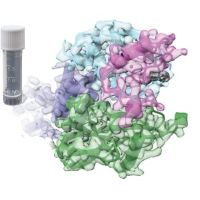Specification
| Description | Recombinant protein from the full-length sequence of Homo sapiens Fas apoptotic inhibitory molecule 2 (FAIM2) (NM_012306). |
| Organism | Homo sapiens (Human) |
| Expression Host | Human Cells |
| Tag Info | His or DYKDDDDK. Please contact us if you need further information or require specific designed tag. |
| Purity | Greater than 90% by SDS-PAGE gel |
| Uniprot ID | Q9BWQ8 |
| Entry Name | LFG2_HUMAN |
| Gene Names | FAIM2 KIAA0950 LFG LFG2 NMP35 TMBIM2 |
| Alternative Gene Names | KIAA0950 LFG LFG2 NMP35 TMBIM2 |
| Alternative Protein Names | Protein lifeguard 2 (Fas apoptotic inhibitory molecule 2) (Neural membrane protein 35) (Transmembrane BAX inhibitor motif-containing protein 2) |
| Application | Antigens, Western, ELISA and other in vitro binding or in vivo functional assays, and protein-protein interaction studies; For research & development use only! |
| Buffer | Purified protein formulated in a sterile solution of PBS buffer, pH7.2, without any preservatives |
| Endotoxin | Endotoxin level is < 0.1 ng/µg of protein (<1EU /µg) |
| Length | 316 |
| Molecular Weight(Da) | 35110 |
| Protein Sequence | (The sequence of expressed protein may have some variation from the sequence shown below. Please contact us for the exact sequence.) MTQGKLSVANKAPGTEGQQQVHGEKKEAPAVPSAPPSYEEATSGEGMKAGAFPPAPTAVPLHPSWAYVDPSSSSSYDNGFPTGDHELFTTFSWDDQKVRRVFVRKVYTILLIQLLVTLAVVALFTFCDPVKDYVQANPGWYWASYAVFFATYLTLACCSGPRRHFPWNLILLTVFTLSMAYLTGMLSSYYNTTSVLLCLGITALVCLSVTVFSFQTKFDFTSCQGVLFVLLMTLFFSGLILAILLPFQYVPWLHAVYAALGAGVFTLFLALDTQLLMGNRRHSLSPEEYIFGALNIYLDIIYIFTFFLQLFGTNRE |
Background
| Function | FUNCTION: Antiapoptotic protein which protects cells uniquely from Fas-induced apoptosis. Regulates Fas-mediated apoptosis in neurons by interfering with caspase-8 activation. May play a role in cerebellar development by affecting cerebellar size, internal granular layer (IGL) thickness, and Purkinje cell (PC) development. {ECO:0000269|PubMed:10535980, ECO:0000269|PubMed:17635665}. |
| Pathway | |
| Protein Families | BI1 family, LFG subfamily |
| Tissue Specificity | Highly expressed in breast carcinoma tissues. Enhanced expression correlates with the grade of the tumor (grade II/grade III) in primary breast tumors (at protein level). Widely expressed. Expressed at high levels in the brain especially in the hippocampus. {ECO:0000269|PubMed:10535980, ECO:0000269|PubMed:20336406}. |
QC Data
| Note | Please contact us for QC Data |
| Product Image (Reference Only) |  |

